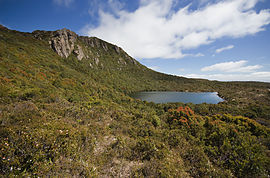Hartz Mountains National Park
|
Hartz Mountains National Park Tasmania |
|
|---|---|
|
IUCN category II (national park)
|
|

Ladies Tarn, Hartz National Park
|
|
| Nearest town or city | Huonville |
| Coordinates | 43°13′47″S 146°45′22″E / 43.22972°S 146.75611°ECoordinates: 43°13′47″S 146°45′22″E / 43.22972°S 146.75611°E |
| Established | 1939 |
| Area | 71.4 km2 (27.6 sq mi) |
| Visitation | 11,800 (in 2005) |
| Managing authorities | Tasmania Parks and Wildlife Service |
| Website | Hartz Mountains National Park |
| See also | Protected areas of Tasmania |
Hartz Mountains National Park is located in the south of Tasmania, Australia. It is one of 19 Tasmanian National Parks, and in 1989 it was included in the Tasmanian Wilderness World Heritage Area, in recognition of its natural and cultural values. The Hartz Mountains were named after the Harz mountain range in Germany.
Most of the park is over 600 metres above sea level, with altitudes ranging from 160 m at the Picton River to 1,255 m at Hartz Peak. The backbone of rock in the park is dolerite, while the southern areas at lower altitudes are constituted from sedimentary rocks formed from sediments deposited by marine, glacial and freshwater sources between 355 and 180 million years ago. The relief has been modified over time by several ice ages, forming cirques, horn peaks, aretes and glacial troughs.
The varied vegetation includes wet eucalypt forests, mixed forests dominated by stringybark (Eucalyptus obliqua), rainforests, sub-alpine and alpine forests. The rainforest communities are dominated by myrtle (Nothofagus cunninghamii), sassafras (Atherosperma moschatum), leatherwood (Eucryphia lucida) and native laurel (Anopterus glandulosus). The sub-alpine forests are dominated by three eucalypt types: snow gum (Eucalyptus coccifera), varnished gum (E. vernicosa), Australia's smallest eucalypt, and yellow gum (E. subcrenulata). Much of the understorey is made of heath plants, including the Tasmanian waratah (Telopea truncata).
...
Wikipedia

